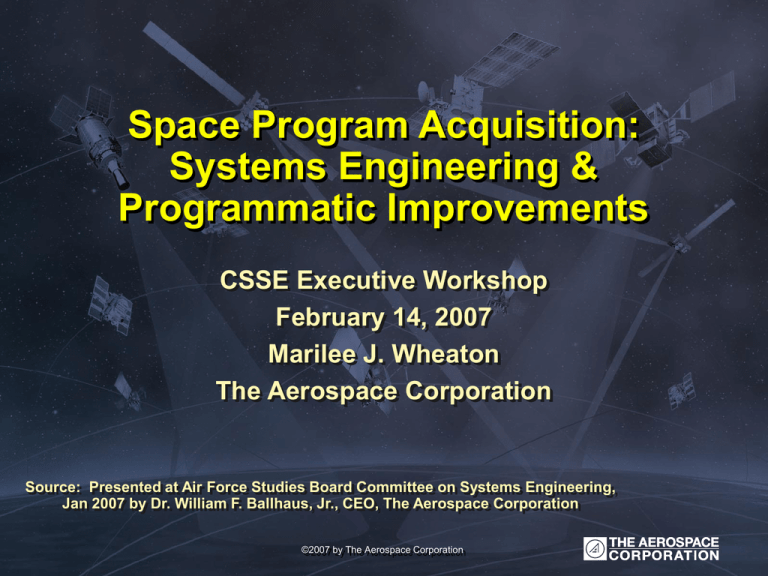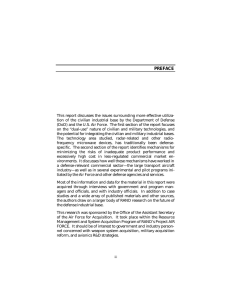Space Program Acquisition: Systems Engineering & Programmatic Improvements CSSE Executive Workshop
advertisement

Space Program Acquisition: Systems Engineering & Programmatic Improvements CSSE Executive Workshop February 14, 2007 Marilee J. Wheaton The Aerospace Corporation Source: Presented at Air Force Studies Board Committee on Systems Engineering, Jan 2007 by Dr. William F. Ballhaus, Jr., CEO, The Aerospace Corporation ©2007 by The Aerospace Corporation Systemic Problem: Erosion of Testing and Systems Engineering Practices % SV With Mission Critical Failures* Test Erosion Since 1995* Test Thoroughness % Space Vehicles With MCFs 100 Six-fold Increase 90 Pre-1995 Post-1995 80 70 60 50 Pre-95 Post-95 NRO Programs SMC Programs (2003) • “Peace Dividend” budget led to deviations from conventional T&E, quality, and system engineering • Increasing complexity on NSS systems is posing a greater challenge to these processes *J. Bell, S. Pavlica, W. Tosney, “An Assessment of NRO Satellite Development Practices,” Report No. TOR 2003(8542) 2530E (The Aerospace Corporation, El Segundo, CA, March 2003) 0023-07 2 1000 Source Lines Of Code (KSLOC) Size, Complexity, and Criticality Increasing SMC Estimated Software Trend Future systems: Upwards of 1MSLOC Legacy systems: Sub 100KSLOC Diverging Code Complexity! 0023-07 Aerospace Cross-Program Research Office May 12, 2006 3 Key Attributes of Successful Systems Engineering • People and teamwork • Controlling risk • Processes • Accountability • Stability 0023-07 4 People and Teamwork • Rebuild the system engineering workforce • Aspiring government program managers and systems engineers learn by leading & managing component and subsystem developments at contractor sites • Are contractors managing people as part of their core competencies? Or as a commodity? • Are people getting at least 40 hours of management/engineering training per year? 0023-07 5 People and Teamwork (Cont.) • Three tiers to ensure mission success: – Contractor execution team should be first line of defense for mission success – Second line is contractor functional organization check and balance – Third line is government, FFRDC and SETA team – Government team is not staffed to be the first line of defense • Space Quality Improvement Council (SQIC) – Contractor-Government problem solving and information sharing collaboration – Non-attribution industry input to the government, facilitated by The Aerospace Corporation 0023-07 6 Key Attributes of Successful Systems Engineering • People and teamwork • Controlling risk • Processes • Accountability • Stability 0023-07 7 How Do We Control Risk? • Four variables in project management: cost, schedule, performance, and risk • Need to rigorously define all relevant risks and cap it at an acceptable level but not lose sight of the entire set of risks • If you cap the other three variables, risk grows continuously – Example: 1990s NASA Mars missions, which failed Assertion: Capping risk and driving schedule hard leads to best cost performance 0023-07 8 How Do You Cap Risk? • Use standards for engineering and manufacturing – Appropriate test program, robust QA, PMP, etc. • Rigorous system engineering and test – Example: JPL Mars Rover “incompressible test list” – Test like you fly, fly like you test • Manage risk at a sufficiently senior level on a program – Allowing lower levels to trade mission success for cost and schedule leads to unbounded risk 0023-07 9 How Do You Cap Risk? (Cont.) • Government/industry team manages risk incrementally – Robust mission assurance tailored to risk assessment – Contractor uses “buildup” process in design and test to define and manage risk – Establish confidence at each major step—not just at the end of the program – Find and fix defects early – Revisit original program risk to ensure that any that warrant addition receive appropriate attention • Establish environment that encourages problem reporting – Example: Weekly Watchlist (ROE—“No Ambushes”) 0023-07 10 Key Attributes of Successful Systems Engineering • People and teamwork • Controlling risk • Processes • Accountability • Stability 0023-07 11 Processes • Prevent repeating past mistakes – Use validated processes that ensure predictable, repeatable results – Specs & standards and best practices represent knowledge gained from past experiences – Require credible independent assessments prior to program initiation and at key milestones • Rigorously manage the baseline implementation • Fund and manage disciplined, validated technology insertion • Recognize the impact of software in the program – Develop a systemic point-of-view of both the acquirer and developer perspectives and work toward convergence – Require each acquisition program to develop an executable software acquisition management plan – Apply validated process measurement tools to mitigate structural software risks 0023-07 12 Processes (Cont.) • Require government SE planning and document through plans – Systems Engineering Plan (SEP) and Operational Safety, Suitability and Effectiveness (OSS&E) are required SE management plans – SE organization and technical authority – Process selection and implementation – Technical management and control – “-ilities” • Infuse the operational requirements into the developmental T&E processes – Characterize operational requirements early – Assure system requirements are verified at the system level (end-to-end) 0023-07 13 Specifications and Standards • Essential specifications & standards developed for acquisition contacts – Dozens, not hundreds – Government, program office and FFRDCs ensure that “best practices” are being used – Develop needed industry standards – AIAA, MIL-STDs • Part of the technical baseline of the SMC and NRO acquisition process – Defines the government requirements for SE, MA, PM&P, SW, and specialty engineering – Used on 9 new acquisition programs 0023-07 14 Key Attributes of Successful Systems Engineering • People and teamwork • Controlling risk • Processes • Accountability • Stability 0023-07 15 Accountability • Nearly every failure in space systems resulted from a breakdown in accountability • Need clear definition of accountability on government/contractor team – At every organization level and flows down to individuals executing program – Key program people remain in the job long enough to ensure they are accountable for their decisions that affect mission success • Contractor balances holistic enterprise perspective and tailored program needs – Line organizations are accountable for the product – Functional organizations are accountable for the processes – Prime takes accountability for the quality of output by subcontractors and vendors 0023-07 16 Accountability (Cont.) • Government provides a check-and-balance between group, wing, and center roles to – Define requirements, set and manage risks, ensure use of proper practices, and incentivize and assess contractor team – Re-establish Chief Systems Engineers (enterprise and program) must be sufficiently resourced and report at a senior program level – Designate a chief systems-of-systems engineer to assure systems-of-systems optimization (versus component system optimization) 0023-07 17 Chief Systems Engineers (CSEs) Roles and Responsibilities • Back to basics • Baseline Program Offices’ SE Processes • Improve common processes and tools in core SE disciplines • Ensure SE training for all acquisition personnel • Oversee in-plant representation program • Collaborate 0023-07 18 Key Attributes of Successful Systems Engineering • People and teamwork • Controlling risk • Processes • Accountability • Stability 0023-07 19 Stability • Stable, manageable baselines—requirements, budget, and schedule also include managing expectations – Manage necessary but unplanned changes – Rigorous systems engineering process for assessing impact of new requirements – New requirements must come with new funding • Allows trade spaces vs. “cast-in-concrete” requirements – Capabilities, cost, and schedule • Architectures that allow right-sized programs (can be executed in about 5 years) – Regulates appetite of user community 0023-07 20 Government as Smart Buyer • Recognizes that best value is not necessarily lowest cost bid • Government must place value on non-deliverables essential to mission success (Examples: SE, MA, QA,…) – Then industry will also value them – Exclude “name-that-tune-in-three-notes” contractors • Has a well-established Independent Cost Estimating (ICE) and program control function • Budget program to 80% confidence, including a management reserve sized by risk – Expend reserves to execute unforeseen elements of baseline program—not new requirements 0023-07 21 Top 10 IPA Team Finding Areas 1. Poor government cost baseline (e.g., awarding the acquisition contract based on less than government cost estimate) 2. Poor schedule baseline (e.g., awarding the acquisition contract based on a schedule shorter than government schedule estimate, “meet me at the pass” planning, not using technology on/off ramps effectively) 3. Changes in major requirements after acquisition contract award 4. Poor government SPO technical baseline (e.g., at KDP B) – Missing or poor SOO, TRD, WBS/SOW, CARD, Approved Acquisition Strategy – Cutting corners during preparation to save time in getting on contract – Using success-oriented plans (over promise/ under perform) – Assuming that none of those problems that other programs have encountered will happen to this program Source: S. Soderquist, Director, SMC Acquisition Center of Excellence (ACE), presented Jan 2007 Space Systems Cost Analysis Group (SSCAG) Meeting 0023-07 22 Top 10 IPA Team Finding Areas 5. Poor contractor processes and poor implementation of those processes IMS/IMP, EVMS, engineering/qualification equipment Parts/box/subsystem/system testing, configuration control 6. Poor government oversight of contractor processes and testing 7. Program disruption due to problems in government decisions Time required to provide data to independent teams, and lack of timely access to decision makers Time required for RFP preparation and source selection Budget cut drills Difficulties in meeting obligation and expenditure standards, resulting in OSD budget cuts 8. Other system engineering shortfalls Test and Evaluation planning, requirements decomposition and traceability, trades, interface planning 9. SPOs not applying the lessons learned and best practices derived from past program experience 10. Too few qualified people in the SPO and contractors 0023-07 23

